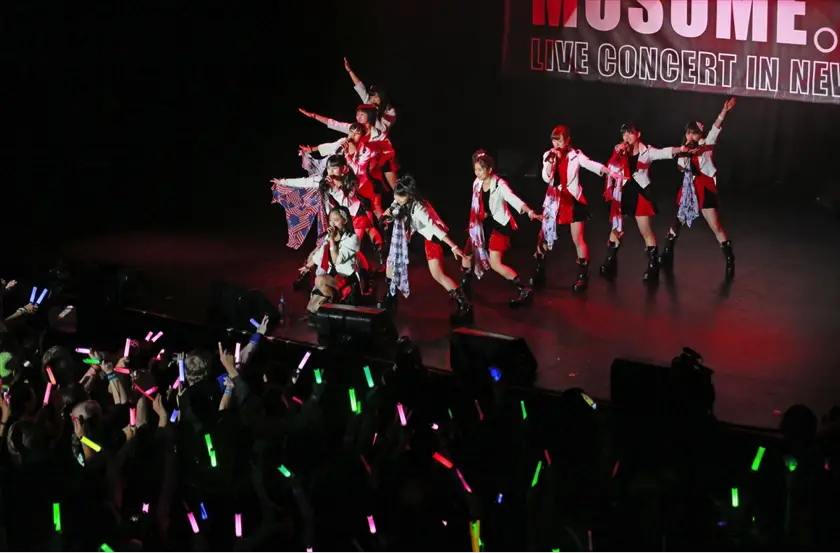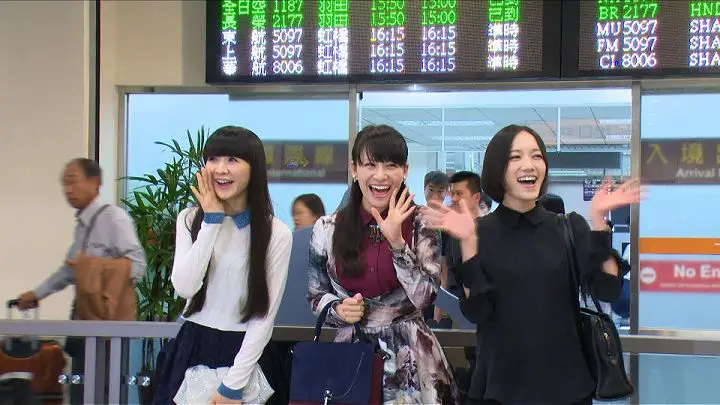Everything You Need to Know About Japanese Concerts, and Then Some
Nothing can really prepare you for the colors, noise and insanity, but we’ll try anyway.
By Emily Suvannasankha, University of Central Florida
The well-meaning, tax-return-filing Dicks and Janes of the world are usually creeped out when I say I like Japanese teenage girls—but that’s because they don’t know the long and short of it.
More accurately, I like Japanese teenage girls so much that I fly thousands of miles across the country all alone, just to stand in their presence and shake their bony white hands for about 3.5 seconds each.
Oh wait, that’s even creepier.
Or endearingly dedicated! Yeah, let’s go with that. Just don’t look at the posters on my bedroom walls—the sheer size and volume of eyes and skin tends to inspire the urge to back away slowly before sprinting away at a record-breaking velocity.
So it stands to reason that compared to said Dicks and Janes, I’m pretty much an expert on Japanese concerts in the United States, the rare causes for ecstatic weeping that they are. (I wish I were kidding.)
Granted, I’ve only actually attended two—and both were for Morning Musume, an idol group most famous for a song called “Love Machine” in 2000, long before most of the current members were qualified to operate any kind of machinery, amorous or otherwise. That is to say, they were actual fetuses.
Ah, the beauty of a rotating lineup of disposable minors whose singing abilities are, to the average ear, only barely passable.
The idol world, am I right? (Oh, I jest. Some of them are legal!)
Anyway, brushing matters of child labor aside, the deal I’m about to lay down doesn’t cover the full spectrum of Japanese musical acts that set sail over the Pacific. I speak from my own chipmunk-voiced, questionably-talented idol-rific experience. You have been warned.
Preparing for the Event (of Your Life)
Here’s the thing: Most of us rabid fanboys and fangirls stranded in the West are downright starved for opportunities to glimpse the lovely faces of our idols in the flesh.
We’ve grown up supporting these musicians through the mocking blue light of our computer monitors, replaying famous YouTube clips of Japanese girls desperately trying to pronounce “refrigerator” until our eyeballs fry through, falling in love with their shoddily taped music videos from 2008 despite the crushing judgment from all of our friends who have no qualms telling us our taste in music is horrendous. And usually I don’t even fight them on that.
For fuck’s sake, we even import multiple copies of their atrociously outdated sound circles! (Read: CDs. That’s right, despite their pancake-flipping robots, Japan can be prehistoric when it comes to letting go.)
To faithfully eccentric circle-hoarders clad in pink birthday t-shirts, any time a Japanese band crash-lands in America is cause for running through the streets while launching backflips off lampposts and high-fiving old ladies as the Japanese national anthem plays in the background. Plane tickets to the fabled homeland are expensive, often to the wallet-igniting tune of $2,000, so one elusive overseas concert is pretty likely to be the first, last or—Shinzo Abe forbid—only chance to see the subjects of our obsession in person, and if we’re lucky/willing to shell out several more paychecks, shake their hands and blubber a few mispronounced words. Handshake events are occasions that call for prepping. Language prepping. You know, so you don’t sound like a guns-a-blazin’ cowboy half-choking on a McFlurry who makes himself heard at dangerous decibels and pronounces “wo” like the sound of realization you make when you find out the “w” is silent.
Handshake events are occasions that call for prepping. Language prepping. You know, so you don’t sound like a guns-a-blazin’ cowboy half-choking on a McFlurry who makes himself heard at dangerous decibels and pronounces “wo” like the sound of realization you make when you find out the “w” is silent.
Let’s just say that in the midst of all the booking of hotel rooms for one (as no amount of begging, bribing or blackmailing could get anyone you know—not even your mom—to come along), importing of thrillingly sparkly LED light sticks and emotional bracing of your heart as the hand-shaking fantasies (whoa there) grow more vivid, it would be a good idea to learn how to say “arigatou gozaimasu” like a person who’s heard of Japan before.
Meeting International Fans
In my experience, lines for Japanese concerts are long and start early—especially if they’re not held at an anime convention and people are free to pitch their tents right on the welcome mat days in advance. So while you stand queued on the streets of New York City for five hours trying not to saw your legs off just for some sweet, sweet relief, you’re likely to run into some Japanese fans.
If it’s an idol concert, these benevolent unicorns, called wota (again with the silent “w”), might pass out a little free merchandise, give you some concert-chanting advice or simply trade Twitter handles with you. But most importantly, if they’re anything like the group of Japanese wota I met in Houston, they’ll welcome you and your spirited attempts to speak the language you’ve been studying for the past six years, and tease you about snatching the attention of your favorite member idly twiddling her thumbs three feet away.
Well. Maybe they won’t. But at least you’ll get the chance to observe the fascinating dynamics of two cultures connecting and contrasting over a shared underground fandom.
At the concerts I’ve attended, I’ve noticed that Japanese wota tend to be calmer, more prepared and certainly more in control of their tear ducts, while the Western fans flip out like howler monkeys at the slightest glimpse of a hair bow through an elevator door 80 yards away.
The difference is understandable, like dangling food before a starved kitten and a well-fed one, but still nothing short of comical.
It’s a special kind of camaraderie that’s fostered on the cold tile of a convention center between hungry, anxious, freshly bankrupt concertgoers thousands of miles from home, flipping through strangers’ binders bursting with official photos and rehearsing fancy light stick choreography for the concert they’ve all anticipated more nail-bitingly than they’re proud of.
Experiencing the Concert
There’s nothing quite like the feeling of being surrounded by screeching loonies in a sea of glowing rainbow plastic.
What I remember most clearly about my first concert in 2014 isn’t being alone at night on the streets of New York City, or the eardrum-shattering volume of the music, or even the feel of my favorite member’s hands squeezing mine (though that’s up there). It’s how intensely, unmistakably special it felt to stand there, alone in the middle of the crowd, knowing that this was all I’d wished for for years. And how I rushed outside to the freezing city sidewalk to jot down every little detail I could remember on my phone so I could relive the night later—years later. And how I couldn’t stop chattering about how happy I was back in the hotel room, when nothing lay ahead of me but the trip back to Florida and high school, and I wasn’t even sad about it.
It’s how intensely, unmistakably special it felt to stand there, alone in the middle of the crowd, knowing that this was all I’d wished for for years. And how I rushed outside to the freezing city sidewalk to jot down every little detail I could remember on my phone so I could relive the night later—years later. And how I couldn’t stop chattering about how happy I was back in the hotel room, when nothing lay ahead of me but the trip back to Florida and high school, and I wasn’t even sad about it.
When they dimmed the lights and the girls came onstage one by one after hours of waiting, months of anticipation, years of learning foreign lyrics by sound until they grew meaning—my whole body shook like a rag doll. I’m surprised no one called the paramedics.
Those moments don’t come often in life. There’s this soft clarity that squeaks between jostling drifters and boohooing fangirls and into your mind, sometime after the electricity of the first few songs and the somber intimacy of the encore.
In that dark room filled with strangers, it dawns on you, overwhelmingly and all at once, that this is where you’re supposed to be, where you’re all supposed to be. Nothing else in the world matters except this beautiful, unreasonably-priced, entirely too-loud and undoubtedly too-short cultural clusterfuck.
At least, that’s what concerts are like for me. Was that flowery enough for ya? Did I lay it on thick enough? Good, because I think you’ll appreciate what I have to say next.
No groping the pretty Japanese girls. I know they look soft and huggable, but try to restrain yourself. That’s what they make dakimakura for, after all. Or, you know, straitjackets.
And now that we’re back to creepy, I encourage anyone who’s ever gotten cozy with a Japanese track or two in a corner far away from all their loved ones to keep their eyes peeled back—with clothespins, if necessary—for concerts in the West. They’re few and far between, but they do happen every once in a while.
For what it’s worth, I recommend the band Goose House for some genuinely catchy Japanese music that isn’t marked by short skirts and questionable talent. Quite the opposite, actually. See? Japan isn’t all weird.
Except for Kyary Pamyu Pamyu. That shit is whack.










[…] and today it is considered to be one of the most popular sub-cultures all across the globe — Japan and America are the most notable cosplaying […]